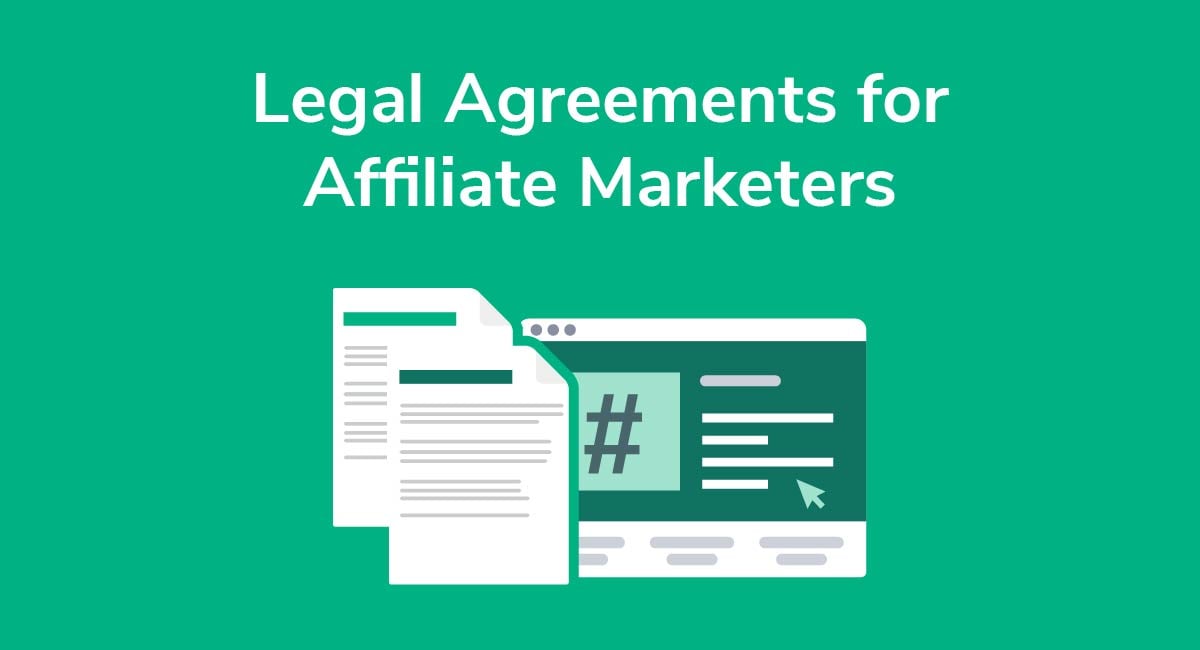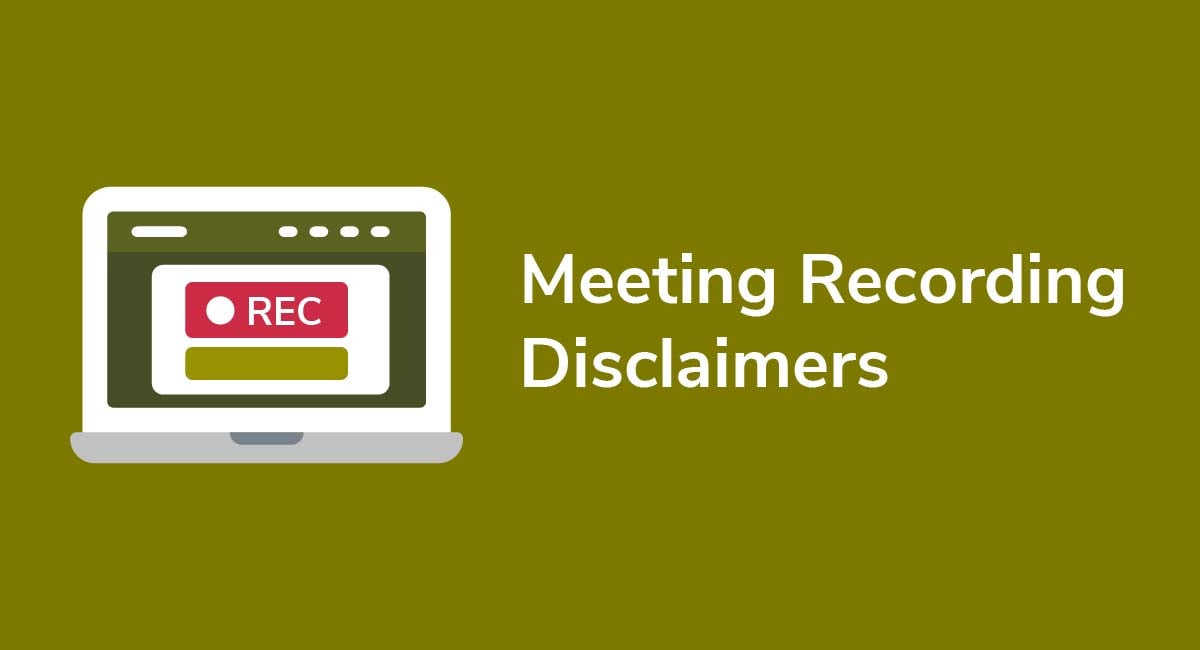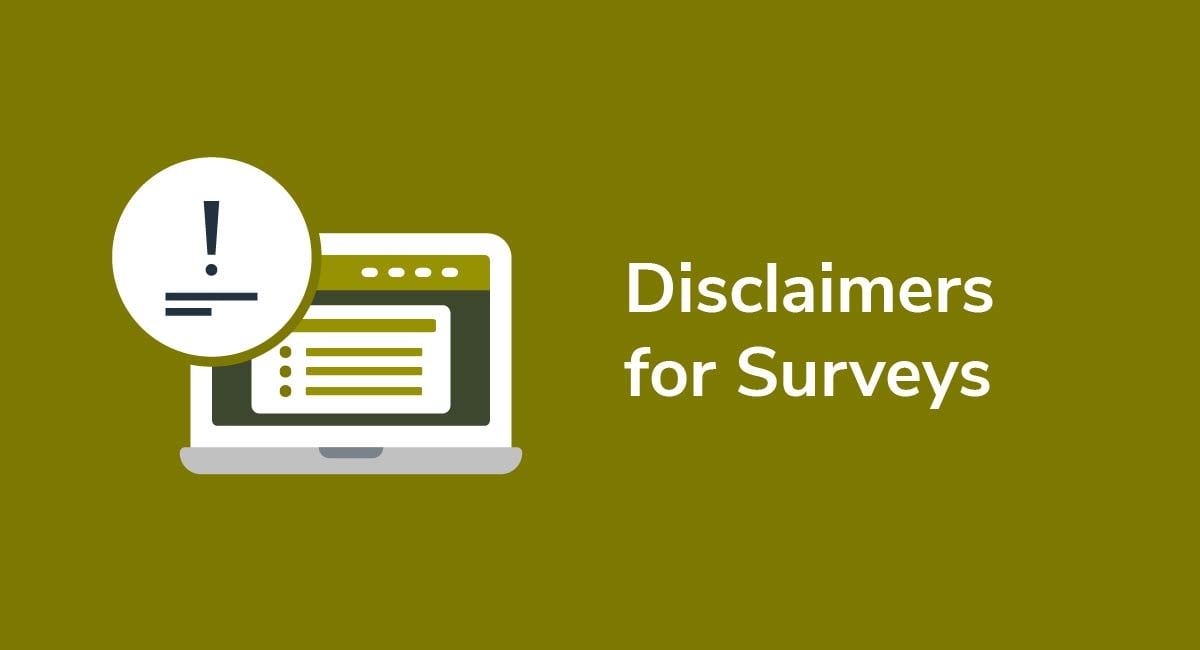Disclaimer Examples
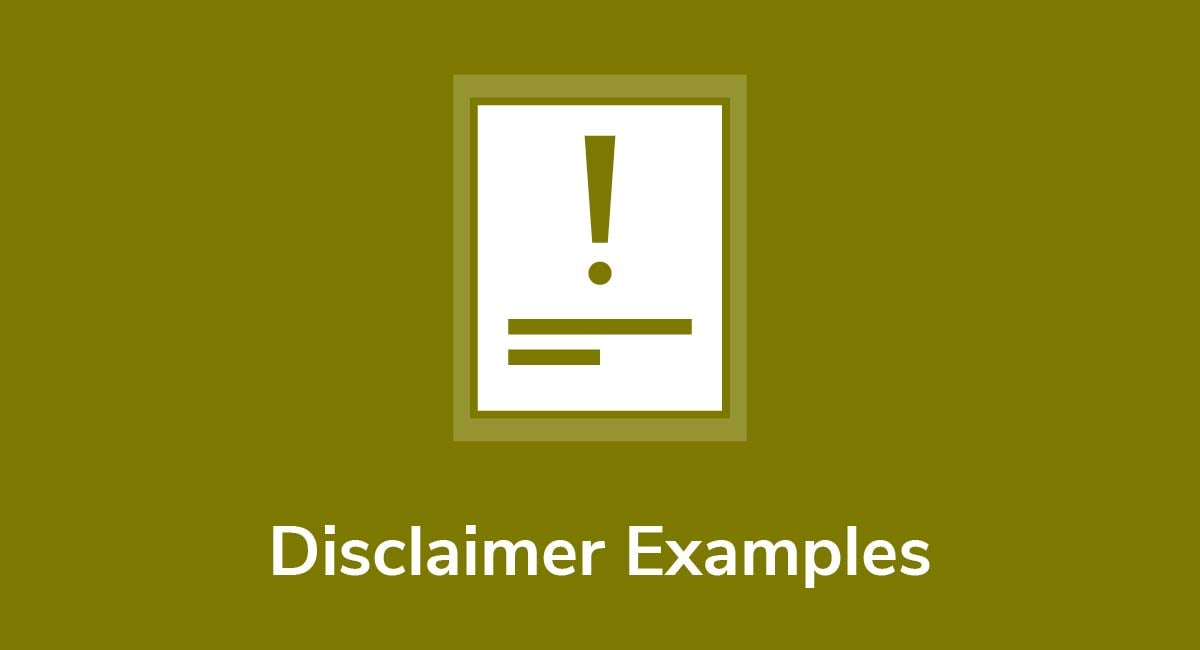
A disclaimer is a notice that lets your website visitors know that your liability is limited in certain circumstances, and that they need to be aware of this when they use your site.
Disclaimers can be found as stand-alone, separate pages on a website, as part of a webpage, or within legal agreements such as a Privacy Policy or Terms and Conditions agreement.
We'll show you when you should use disclaimers, give examples of some of the most commonly-used and important disclaimers, and provide tips on how to best display your disclaimers.
Get compliant today with PrivacyPolicies.com
Select one of our generators to create the required legal agreements for your business:
- Our Privacy Policy Generator can help you generate a customized Privacy Policy in around three minutes, for free.
- Our Terms & Conditions Generator can help you generate a customized Terms & Conditions agreement in around three minutes, for free.
- Our EULA Generator can create a customized End-User License Agreement for your mobile or desktop app.
- Our Cookies Policy Generator can create a customized Cookies Policy to help your compliance with ePrivacy Directive and GDPR.
- Our Disclaimer Generator can create a disclaimer or disclosure for your website.
- Our Return & Refund Policy Generator can help your ecommerce store by creating a returns or refunds policy.
Integrate a free Cookies Notice and Cookie Consent banner to comply with the EU ePrivacy Directive and the new GDPR law regarding cookies.
- 1. Why are Disclaimers Important
- 2. Who Should Use a Disclaimer
- 3. What to Include in Your Disclaimer
- 4. Examples of Common Types of Disclaimers
- 4.1. 1. Views Expressed Disclaimer Example
- 4.2. 2. Past Performance Disclaimer Example
- 4.3. 3. Professional Advice Disclaimer Example
- 4.4. 4. Use at Your Own Risk Disclaimer Example
- 4.5. 5. Health and Fitness Disclaimer Example
- 4.6. 6. As-Is or Disclaimer of Warranties Example
- 4.7. 7. Financial Disclaimer Example
- 4.8. 8. Third Party Link Disclaimer Example
- 4.9. 9. Third-Party Disclaimer Example
- 4.10. 10. Errors and Omissions Disclaimer Example
- 4.11. 11. Affiliate Disclaimer Example
- 5. Examples of How and Where to Display Disclaimers
- 5.1. Within Legal Agreements
- 5.2. On a Separate Disclaimers Page
- 5.3. Near Specific Content
- 6. Copying Disclaimers and Using Disclaimer Templates
- 7. Conclusion
Why are Disclaimers Important
Disclaimers can't eliminate the risk of future legal action against you, but they're a relatively easy and inexpensive way to limit exposure to litigation.
According to the Miriam-Webster online dictionary, a disclaimer is defined as "a denial or disavowal of legal claim...a writing that embodies a legal disclaimer."
A well-written disclaimer can help you:
- Protect ownership of your intellectual property
- Dissuade others from using your intellectual property without authorization
- Safeguard you from claims that you stole, copied or used someone else's intellectual property inappropriately
Though you may not pay them much mind, you'll find disclaimers on nearly every website, and yours should have one too.
Despite making every attempt to ensure accuracy, your website may still contain information that is:
- Vague
- Misleading
- Incorrect
Thankfully, a disclaimer may still help deflect liability if a claim arises from harm caused by your site.
Who Should Use a Disclaimer
Disclaimers should be used by bloggers and website owners interested in protecting their interests from legal action arising from online commerce and publishing.
In fact they're so vital, a better question may be, "Who shouldn't use a disclaimer?"
Some common instances where you'll see disclaimers used are as follows:
- Blogs that give advice, such as financial, medical, or legal - No professional relationship formed disclaimer
- Blogs that give instructions, such as DIY projects and how-to websites - Use at your own risk disclaimers
- Anything health related, such as weight loss programs, detox protocols - No medical advice, or results not typical disclaimers
- Opinion blogs - Views expressed disclaimers
- Ecommerce sites - Sold as-is, no warranty or liability disclaimers
- Websites that use affiliate marketing links - Affiliate disclaimers
What to Include in Your Disclaimer
Disclaimer content is largely dictated by your business and what type of blog or website you own.
Significant differences exist between industries and companies, but disclaimers should address each area in which you're open to liability.
The best disclaimers are tailor made, but most incorporate many of the same elements.
When crafting a disclaimer, put yourself in your users' shoes to uncover areas in which you're vulnerable.
Better yet, enlist the help of coworkers, friends and family, as well as others who have gone through the process of making their own disclaimers.
If you're drawing blanks, you'll likely find much of what you're looking for in disclaimers used by those with businesses similar to yours.
Examples of Common Types of Disclaimers

The sheer diversity of blogs, websites and social media platforms is staggering.
Since no one-size-fits-all approach can ensure that the individual aspects of each are addressed sufficiently, disclaimers come in a variety of forms.
Though they're all different most share common elements, more than one of which may be relevant to you.
Here are some examples of the most commonly-used and important disclaimers.
1. Views Expressed Disclaimer Example
Views Expressed Disclaimers advise users that views and opinions belong solely to the author, and don't necessarily align with yours or those of your employees just because you're the owner.
Without them, readers may reasonably assume the opposite is true.
They're typically found on:
- Blogs
- Critiques
- Op-ed articles
- Commentaries
- Financial websites
- Sites that frequently have guest posts
- News and news aggregation websites
Here's an example of such a disclaimer:

2. Past Performance Disclaimer Example
Past Performance Disclaimers are primarily used with products and services that advertise particular results so that viewers know that these past results aren't the norm.
For example, as a precious metals seller you may claim that "between 2020 and 2022 gold's value more than tripled!"
Even if that were to be true, it doesn't guarantee similar results in the future, so you'd be wise to incorporate a Past Performance Disclaimer.
Below is a portion of Investing.com's Risk Warning Disclaimer:
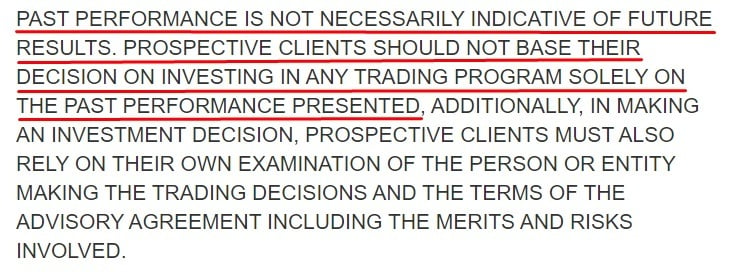
3. Professional Advice Disclaimer Example
Professional Advice Disclaimers are used to protect authors, bloggers and business owners from legal actions that may result when users interpret their published material or opinions as professional advice.
The screenshot below includes the first two paragraphs of Fitness Blender's Professional Advice Disclaimer, which is found in its Terms of Use agreement.

It could also be characterized as a Health and Fitness Disclaimer.
Typically, this type of disclaimer will include the statement that the content or material on the website is for educational purposes only and is not to be used as professional advice.
4. Use at Your Own Risk Disclaimer Example
Use at Your Own Risk Disclaimers are often used by businesses that manufacture or sell products capable of causing serious injury or death.
For example, a slingshot manufacturer may label its packaging to let buyers know that if they're injured when using the product, the company isn't liable.
It's also commonly used to disclaim liability on content, such as a blog post on how to use a chainsaw to cut down a tree. The reader would be reminded to use the instructions at their own risk, and so the blog owner is disclaiming liability for any injuries that may result from someone following the instructions.
Here's an example:

5. Health and Fitness Disclaimer Example
Health and Fitness Disclaimers typically warn users that before starting treatment, a diet, or engaging in a fitness program they should consult a physician, registered dietician, or certified personal trainer.
Below is a sample from Now Foods:

6. As-Is or Disclaimer of Warranties Example
An As-Is Disclaimer or Disclaimer of Warranties states that vendors make no claims about the condition of the items or services they're providing, and that the user/buyer accepts them as they are, except in regard to warranties specifically listed in a contract.
They're also common in real estate transactions and on ecommerce sites where buyers purchase used products like cars and machinery.
The following example is from Merriam-Webster's online dictionary:

7. Financial Disclaimer Example
A Financial Disclaimer is a statement intended to limit liability by declaring that the party providing information is not legally responsible for how it's used.
Financial disclaimers typically state that:
- The information provided does not constitute a suggestion or advice
- The products and services mentioned or linked to are not necessarily endorsed by the author
- The author cannot be held liable for losses incurred from using the aforementioned products and services
Below is a portion of Euro Pacific Capital's Financial Disclaimer:

8. Third Party Link Disclaimer Example
When links are included on your blog, website and social media posts, you may wish to state that you're not responsible for content posted on sites you link to.
Daily Kos has done that here:

9. Third-Party Disclaimer Example
These types of disclaimers help limit liability on websites that link to partner or affiliate sites, as well as social media platforms on which comments, submissions and advertisements are common.
In addition to the interaction between you and your users, your blog or website may deal with third parties.
Limiting your own liability may be enough of a challenge, but you'll also need to do so for the third parties you're affiliated with.
The following is from Tribune Publishing's Third-Party Disclosure:

10. Errors and Omissions Disclaimer Example
This type of disclaimer makes it clear that you are not responsible for any errors or omissions in the content on your site.
Accuracy is a big issue that ensnares many unwitting website owners.
Publishing factual errors and misleading content is common, but even when it's unintended it opens the door to liability..
The following example is from the website of L.A. Rag Maker:

11. Affiliate Disclaimer Example
Affiliate marketers receive commissions when they endorse brands and products on the internet, and the Federal Trade Commission (FTC) requires them to disclose their relationships to promote transparency.
For example, Amazon Associates is an affiliate marketing program through which bloggers and website owners advertise Amazon products on their sites by providing links.
Not surprisingly, Amazon requires third-party partners to have affiliate disclaimers as well.
Web Hosting Hero offers this example of an Affiliate Disclaimer:

Now that you're familiar with some of the most common Disclaimers, let's look at the best ways to display them to your audience.
Examples of How and Where to Display Disclaimers

For the most part, disclaimer placement depends on preference and which type of content is presented on your blog or website.
Here are a few options for placing and displaying your disclaimers.
Within Legal Agreements
Including your disclaimer as part of your Terms and Conditions or other legal agreements makes a lot of sense, because in many ways they're similar.
When you get users to accept your Terms and Conditions agreement and your disclaimers are already included, users will be accepting the disclaimer as well.
For example, hunting, fishing and outdoor retailer Cabela's includes its disclaimers within its Terms of Use and Community Guidelines agreement:
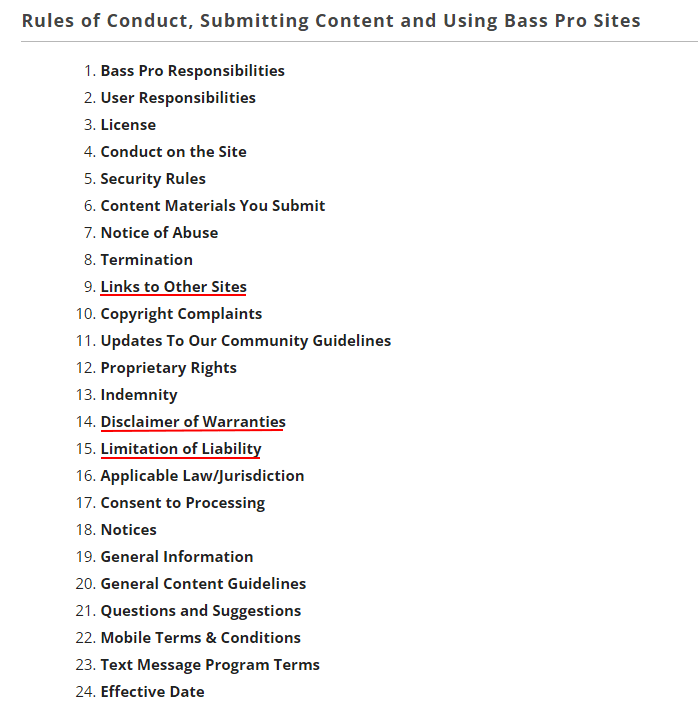
On a Separate Disclaimers Page
Though disclaimers are included within Terms and Conditions on many websites, others have distinct disclaimer sections in their footers or other site navigation menus, and separate pages for disclaimers, like so:
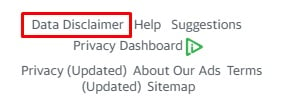
This is a smart move if you have a high number of disclaimers, more complex disclaimers, or operate in a high-liability industry since it really draws more attention to the fact that you have important disclaimers people should take note of.
Near Specific Content
Sponsored content and affiliate links are more prevalent than ever, and they often require disclaimers that should be prominently displayed at or near the beginning of each post or link.
In some instances it's fine to include them at the end, but either way, using the #ad hashtag is a good way to clearly show readers that they're viewing sponsored material.
Here's how a post on Twitter takes advantage of the "ad" hashtag to make it clear that both the original post and repost are both ads:
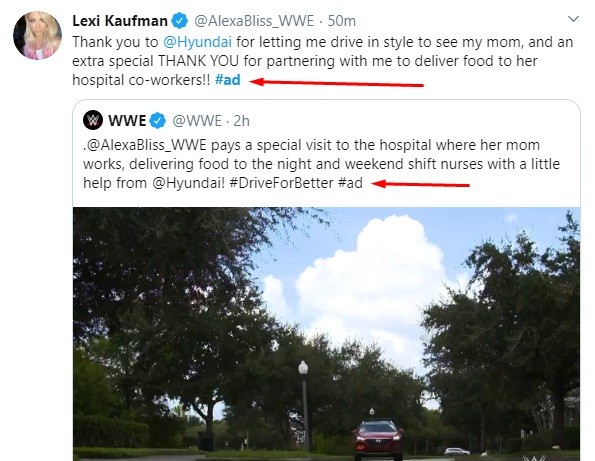
Making sure specific content is clearly marked as being an ad or an affiliate link is important for both transparency and compliance.
Copying Disclaimers and Using Disclaimer Templates

Most bloggers and website owners wouldn't copy a mission statement, logo, or Privacy Policy from a competitor. Similarly, a disclaimer shouldn't be copied.
Remember, your disclaimer should be tailored to the requirements of your specific business.
Using the disclaimers of others for ideas is fine, but taking the content word for word will likely leave you open to liability.
Likewise, using disclaimer templates is a good way to get started, but as you progress you'll want to focus on customization.
Without a clear and accessible disclaimer you'll likely be on shaky ground if legal action is taken against you. However, your disclaimer may significantly strengthen your case if you're sued by a user who claims they were harmed by your website.
Conclusion
Before launching a site it's wise to carefully consider what you'll be publishing and how you can incorporate adequate protections into your disclaimer.
A well-crafted disclaimer may:
- Protect your intellectual property
- Protect you from claims that you used someone else's intellectual property inappropriately
- Limit liability if legal action is taken against you
- Manage user expectations
- Protect your users and customers from damages
Disclaimers should be:
- Easy to find
- As clear and error free as possible
Disclaimers are usually displayed as a subsection within a Terms of Use agreement but can and should be displayed elsewhere, too.
The most common types of disclaimers include:
- Use at Your Own Risk
- Professional Advice
- Past Performance
- Affiliate Links
- Views Expressed
- Disclaimer of Warranties/Limitation of Liability
- Health and Fitness
- Financial
- As-Is
